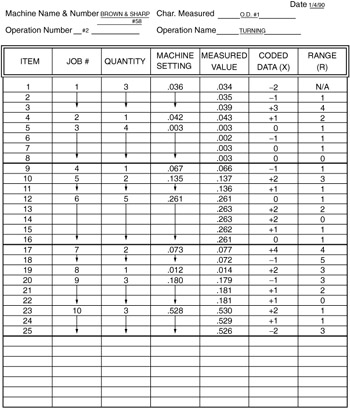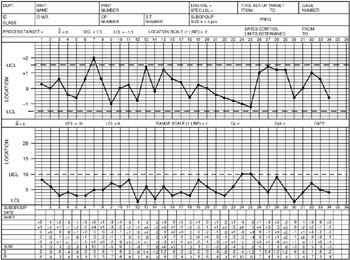CODED DATA
Under normal conditions, the variable control charts continually monitor the behavior of the process during large runs ( n > 100). The variation and control limits of these charts reflect the behavior of the process over time. However, when we deal with processes with very small runs ( n = 1), we can no longer afford to wait and plot the appropriate points for evaluation. By the time the evaluation is applicable and appropriate, time may have lapsed and the product may, in fact, have been shipped to the customer.
We can circumvent this situation with coding. This is possible if the actual measured readings are coded as variation from a common reference point, in this case the nominal print specification. Figure 13.1 shows a typical data collection sheet used in a short-run activity. The reader will notice that in this form, there are a variety of jobs, with each job having a varying quantity and a different setting. In this example, we are using an Individual X and Moving Range chart.

Figure 13.1: Data collection sheet for short-run control charting.
When this nominal value becomes the zero point for the subgroup averages of this part number on the Xbar control chart scale (see Figure 13.2), this transformation is called coding. This coding is useful, provided that the code is understood , and is much more convenient that the original uncoded data. (In our examples, we purposely use a different control chart from that used for the data in Figure 13.1 to show the reader that once the data has been coded, they may be applied to different situations. In this case, we have chosen an Xbar and R chart.)

Figure 13.2: A typical control chart with coded values.
To begin coding, a zero base must be determined. This value comes from the actual machine setting, giving a value of zero at that point. The equation for calculating coded data is
Coded data = (reading - zero base)/unit of measurement
where
| reading | = | the actual measured reading taken from a part |
| Zero base | = | the machine setting |
| unit of measurement | = | the accuracy of the measuring instrument |
As an example, let us calculate a coded data point. A part specification calls for an outside diameter of 1.0035 inches; therefore, this is the zero base. The measuring device measures to 0.0001. The machine is set at the specified value, and the process takes place. After the process is completed, a value of 1.0031 inches is measured. This becomes the reading. Now we can figure out the coded point by using the formula
Coded data = (1.0031 - 1.0035)/.0001 = -4
By using this method, the zero base can be changed any number of times, as can the unit of measurement, without affecting the consistency and accuracy of the data, provided of course that the part characteristic remains the constant.
Coding is used in short-run control charting because it allows us to evaluate the behavior of the process regardless of how many samples we have. Now let us examine how one would go about using this coding methodology in a given situation.
-
Step 1: Determine the nominal specification (from the blueprints) for each part number that will be charted.
Part Number
Specification
Tolerance
Nominal Value
A
30 “40
10
35
B
40 “50
10
45
C
45 “55
10
50
D
40 “60
20
50
-
Step 2: Select a part number to begin charting (let's start with "A"). Collect the pieces ( n = 3) for the first subgroup and measure each piece.
Part #A Subgroup #1
31
33
32
-
Step 3: Subtract the nominal value for part number A (35) from each piece measurement. This difference becomes a measure of the variation from nominal. Then calculate the average (
 ) and range ( R ) of the "coded" data from this first subgroup.
) and range ( R ) of the "coded" data from this first subgroup. Part # A Subgroup #1
Part #A Nominal
Coded Data
31
35
-4
33
35
-2
32
35
-3
ˆ‘ (coded X i ) = - 9
 of coded data = -3
of coded data = -3 R of coded data = 2
The Xbar value of -3 and range of 2 for the coded data are plotted on the nominal Xbar, R chart. The zero value on the scale of the nominal Xbar chart becomes the target for the coded subgroup averages of all part numbers .
-
Step 4: Repeat Step 3 for each subgroup collected while running Part A.
-
Step 5: When another part number (say, B) is chosen for production on this equipment, use its nominal value (say, 45) to code the subgroup data and continue plotting on the same nominal Xbar, R chart used for A.
Part #B Subgroup #1
Part #B Nominal
Coded Data
47
45
2
45
45
46
45
1
ˆ‘ (coded X i ) = 3
 of coded data = 1
of coded data = 1 R of coded data = 2
-
Step 6: Continue to plot all subgroups from Part B's production, then Part C's, and so on. When 20 subgroups have been plotted ( k = 20), first calculate the average range,
 , as shown below using the ranges of the coded data. Then calculate the center line ( CL ) of the nominal Xbar chart using the Xbars of the coded data. The control limits are calculated with the following formulas.
, as shown below using the ranges of the coded data. Then calculate the center line ( CL ) of the nominal Xbar chart using the Xbars of the coded data. The control limits are calculated with the following formulas. 
-
Step 7: Draw these center lines and control limits on the nominal Xbar and R chart and then interpret, as before. Figure 13.1 has all points coded and plotted.
EAN: 2147483647
Pages: 181